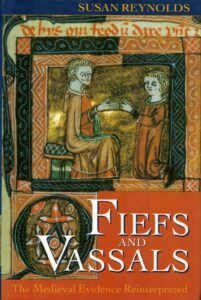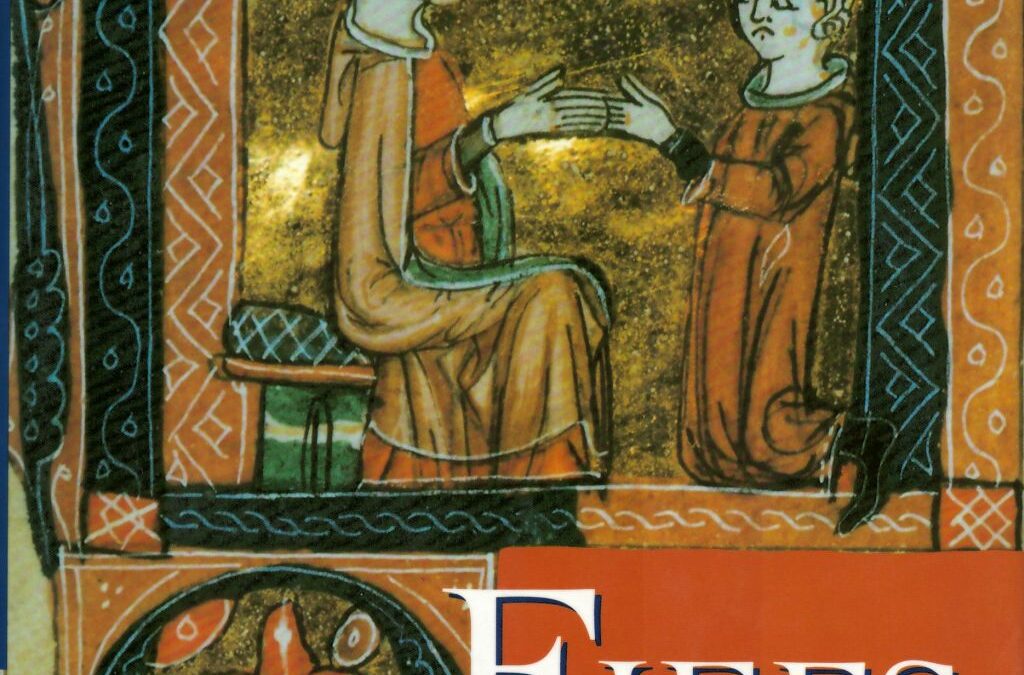
Cover of ‘Fiefs & Vassals’, by Susan Reynolds
In the first of two posts David Bates, former IHR Director, celebrates the life of Susan Reynolds.
A celebration of the life of Susan Reynolds who died on 29 July 2021 at the age of 92 has to begin with a quotation from one of her most influential books, Fiefs and Vassals, published in 1994. In the first sentence of the Acknowledgements she wrote that in writing the book she had incurred many debts. The second sentence said that ‘first and foremost’ her debt was to ‘the staffs of the British Library and the Institute of Historical Research’. To this it must be added that in the same section of Before Eminent Domain, published in 2010, she added the libraries of the Warburg Institute and the Institute of Advanced Legal Studies and the Senate House Library to the list.
As others have remarked, Susan Reynolds truly was a London person. This said, the main reason for referring to the comment made in 1994 is to turn it on its head in order to write about her outstanding contribution to the IHR, an association which went back to the years between 1952 and 1959 when she worked for the VCH.
After she took early retirement from Lady Margaret Hall in 1986, the IHR and the other libraries became the place where she worked regularly. Those years since 1986 have been a time when she followed up on earlier publications and wrote books and articles which have changed how we interpret not just the Middle Ages but the historical past in general. The Wednesday meetings of the Early Medieval Seminar were where her searching questions and lively discussion gave so much help to others and where she herself benefitted from comments and questions. She greatly enjoyed the social life of the Common Room. Her story as an IHR person is one of outstanding generosity from which a huge number of people and the IHR itself have profited.
During my time as Director Susan was Chair of the Friends, a post she held from 2002 to 2008. It was then that the Friends began to fund bursaries to bring Early Career Scholars to the IHR. She was a constant presence at presentations by Junior Research Fellows during that period.
She was liked by IHR staff and gave them helpful advice. Kate Wilcox, a long-serving member of the library staff, has commented to me that the staff ‘always found her very respectful, supportive, kind and appreciative of their work’. She added that Glen, that regular welcoming presence on Reception, was pleased that she always stopped to talk with him and that he enjoyed the stories she told him about the history of the IHR. Samantha Jordan (1970-2017), my PA during my time as Director, often spoke to me about Susan’s kindness to her. Christopher Currie, who has looked in depth at Susan’s work for the VCH, has commented that ‘She joined at an early stage in Ralph Pugh’s modernization of the VCH’s content, funding, and management, when the project was expanding, restarting several new counties, undergoing a physical redesign of the volumes, and rapidly adding new sources, subjects, and approaches to the repertoire and format that had largely been set in stone since 1907’. On her work for Middlesex VCH he comments that ‘The account of the growth of Twickenham, where there had been an old town as well as large and important country houses, almost all by then demolished, followed by modern development, is astonishingly skilled and precocious for its date (1959)’. He adds that, although Susan left the VCH for school teaching in 1959 and then for Oxford in 1964, she was a regular presence at the IHR in the 1970s and the 1980s. More recently, it is interesting that in her ‘Making History’ interview on 27 March 2008, Susan anticipated the separation of seminar rooms and the library which was one of the shaping principles of the refurbishment that had to follow the discovery of asbestos throughout Senate House. This of course broke from one of the founding rules of the IHR which was that seminars should be held in the library so that books could be consulted when matters were in dispute. But it does show how the IHR’s welfare was often in her thoughts and how she believed in the necessity of change.
Susan’s academic contribution has been magnificently described in David D’Avray’s Guardian obituary (https://www.theguardian.com/education/2021/aug/13/susan-reynolds-obituary).
My comments here mostly focus on some examples of Susan’s contributions within the IHR and how her work must be seen as existing in a symbiotic relationship with the IHR’s mission. One such example is her lecture to the July 2005 Anglo-American Conference devoted to the theme of Empires. This lecture, subsequently published in Historical Research, vol. 79 (2006), as ‘Empires: A Problem in Comparative History’, ranges over many centuries and probes incisively how historians of all periods and places should define their terms. A second example is the article published in Historical Research (‘Tenure and Property in Medieval England’, vol. 88 (2015)) which illuminates her regular, and often commented on, reference to the necessity of examining phenomena rather than words. While that statement might be thought an over-modest way of saying that she was well-read in the theories of literary criticism that have transformed intellectual life from the 1970s onwards, it was in that article that she provided some bibliographical demonstration that this was indeed the case.
These two examples have been selected to make the point that Susan was not just someone who wrote books that have changed the way we think about the past, but was someone who was constantly examining her own ideas and whose interests were extraordinarily wide-ranging. Her readiness to travel and to talk to and with others was truly remarkable. For her history never stood still. She was a convincing advocate for the study of the Middle Ages because she constantly exemplified the way in which the values of those times are either still with us or need to be examined in the way we approach later periods. Her essay ‘Secular Power and Authority in the Middle Ages’ in a volume dedicated to the memory of Rees Davies, someone who she greatly admired (Power and Identity in the Middle Ages: Essays in Memory of Rees Davies, ed. Huw Pryce and John Watts (Oxford, 2007)) exemplifies this, with a sentence in the first paragraph slipping into the first person (‘What I maintain’) and feeling like a reflection on the time through which she lived. This and Before Eminent Domain, whose occasional tentativeness is very revealing of the intellectual openness that made her such a stimulus to others, and which is truly global in the treatment it develops, exemplify why she is both an admirable representative of the profession and of the ideals for which the IHR stands and must continue to stand as it enters its second century.
Next week the IHR publishes a second blog, written by Pauline Stafford, which considers the responses to Susan’s death on social media and her commitment to the IHR.

